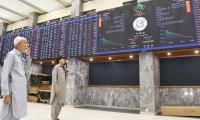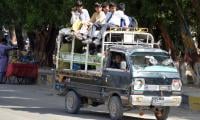The Pakistan Bureau of Statistics (PBS) is the prime institution responsible for collecting data on a variety of matters connected to us. The PBS has divided the whole country into small areas and units – which are referred to as enumeration blocks – to measure trends throughout the country and assess the differences in trends from one place to the other.
The Household Integrated Economic Survey (HIES) is one such product of the PBS. This survey determines the household size and the number of household members who are employed along with their income and consumption patterns. Data is collected by field teams visiting various households and interviewing people who live in them. The latest survey was conducted between September 2015 and June 2016. It covered 24,338 households in all four provinces. The sample was carefully divided across urban and rural lines.
We often make guesses about various elements. When these guesses are repeated, they become believed facts. It is important for us to make well-informed guesses as they can bring us at a proximity to facts.
Quintiles is a statistical term used to divide the population into five consumption quintiles. The poorest 20 percent of the population is placed in the first quintile while the richest 20 percent of the population finds its place in the fifth quintile.
According to this technique, a household with a consumption expenditure that is less than Rs2,810 per capita per month falls in the first quintile and represents the poorest section of the population. A household with an expenditure of between Rs3,628 and Rs5,677 represents the middle class. The richest household spends more than Rs6,526 per capita in consumption expenditures. The bar of these expenditures has been raised by Rs400 for the lower class and Rs700 for the upper class as compared to figures from 2013-14.
I ran a simple Twitter poll. According to that, 63 percent of the respondents believed that less than 20 percent of women are part of the workforce. However, the HIES survey states that 24.07 percent of those who are employed are women. While this appears to be unbelievable, it makes sense when we probe deeper into female employment across the country. As a matter of definition, this includes the agricultural labourers and those women who work as contributing family workers.
Agriculture constitutes the largest share in female employment by engaging 15.51 percent. This is followed by a group of community as well as social and personal services that take up 5.08 percent. The manufacturing sector constitutes up to 2.95 percent of female employment.
In the rural areas of Punjab, KP and Balochistan, 80 percent of the employed women are engaged in agriculture. In Sindh’s rural areas, the figure stands at 71 percent. This shows that we have a lot of areas available to create better opportunities for women to engage in.
In 43.5 percent of households, one person supports at least five other members of the household. Meanwhile, only 29 percent of households have two earners who support around four members. The gap between one-earner and two-earner households is wide and needs to be closed. A large number of industries are available for women and we need to encourage female employment within the community and develop a workplace where women feel comfortable working.
The comparison of average earners per household has its own story to tell. Overall, the average earners per household have only slightly decreased to 1.93 in 2015-16 from 1.94 in 2013-14. The average number of earners has significantly increased in KP and has declined in both Punjab and Sindh. In 2013-14, KP had average number of earners per household 2.04 that has jumped to 2.18 in 2015-16. During the same period, it has reduced from 1.66 to 1.59 in Punjab and from 1.96 to 1.89 in Sindh. For Balochistan, there has been an increase in this figure during the same period from 1.99 to 2.01.
Other important findings of the survey are about the poverty situation. The poorest population in KP – spending Rs2,810 per capita per month – has nearly halved. KP’s population in this poverty group stood at 23.86 percent in 2013-14 and has now dropped to 12.27 percent. During the same time period, Punjab’s population in the poorest quintile has increased from 15.43 percent to 19.62 percent. For Sindh, it has increased from 18.35 percent to 23.41 percent. Like the increase in average earners, for Balochistan, the population in the poorest quintile has fallen from 31 percent to 29.13 percent.
As per the HIES survey from 2013-14, KP has the second highest percentage of people in the poorest quintile. After a two-year gap, the HIES survey was conducted in 2015-16 and found that KP had managed to assist people from the poorest sections of society. Currently, KP has the lowest percentage of its population in the poorest group – a status that was accorded to Punjab two years earlier.
Sindh and KP also witnessed a significant change within their upper middle class. KP’s population in this particular group increased from 18.51 percent to 24.09 percent. In Sindh, the upper middle class has been reduced from 21.05 percent of the population to 17.21 percent.
When it comes to consumption patterns, spending on food, housing and utilities constitutes the largest share. In Punjab, people spend 6.17 percent of their monthly earnings on transport as compared to 3.73 percent in Sindh and 3.89 percent in KP. In real terms, people living in the same consumption group spend Rs583 in Punjab, Rs438 in KP and Rs378 in Sindh on transportation every month. Poorer parents spend only Rs202 per month on education while wealthy parents spend above Rs2,865 per month. Although the burden faced by the poorer segments of society is usually shared by the government through free education and books, an alarming gap in investment on education is creating a class difference in terms of access to quality education.
Over the decades, our government has been conducting surveys and collecting, analysing and disseminating information. But are we putting our resources where they are most needed? Are we redirecting our policy to focus on areas which need to be looked into? Or are we operating on an as-and-when-desired basis?
The writer is an engineer.
Email: ymcheema@gmail.com
Twitter: @Cheemz123
A health worker administers polio vaccine drops to a child during a door-to-door polio vaccination campaign in Lahore,...
Armed militants of the banned Tehreek-e-Taliban Pakistan pose for a photograph in Orakzai Agency. —...
An aeroplane of the national flag carrier of Pakistan is seen in this file photo. — AFPWhile Pakistan considers...
Representational image of a graph depicting various variables. — APP/FileInitiated by the centre and fiercely...
In this picture taken on April 16, 2023, people throng a market area during shopping in Lahore. — AFPOne of the...
Honour crimes also target men. In Sikandar Ali Lashari vs The State, SHC upheld conviction passed by ATC for honour...







